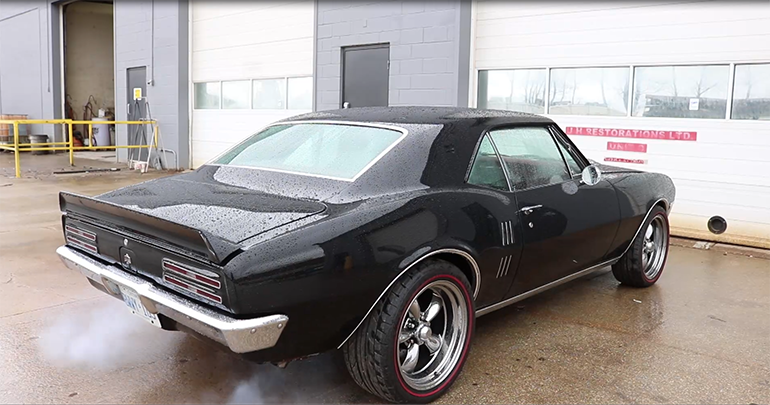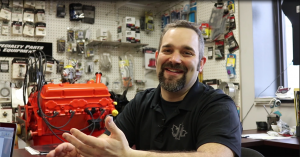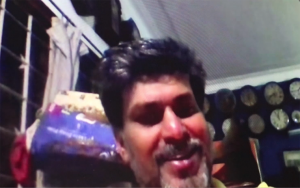Car culture is alive and well throughout the world

Restored Pontiac Firebird outside JH Restorations in Windsor, Ont. Photo by Harshpal Singh
Building an all-electric car from a 1933 vintage Bugatti is an impressive feat, but it also points to a trend.
JH Restoration, as the name suggests is a car restoration firm, and the Windsor, Ont.-based company has successfully developed an all-electric vehicle with an outer body of the vintage car.

Jesse Henke, owner of JH Restoration, Windsor, Ont. in his office. Photo by Harshpal Singh
Jesse Henke, the owner, said his team knows the car industry is shifting to hybrid and electric vehicles even in older cars.
The business was founded by Henke 13 years ago and has since completed hundreds of restoration projects for clients.
The Bugatti took close to 4,000 hours and Henke won’t say how much it cost.
Henke is an engineer and has always had a passion for cars.
“When the industry took a downturn, I just came into the shop, we started selling performance parts and slowly starting building cars from there,” said Henke.
Henke’s firm participated in “the battle of builders” at SEMA’17 in Las Vegas, and while there, he made new connections in the industry.
“We were fortunate enough to be part of the hot road industry alliance and (the liquid) armour booth that garnered us quite a bit of attention. We were sharing the stage with a lot of big-builders,” said Henke, smiling broadly.
Henke’s father used to help people with their builds and that is how it all started.
He spent most of his vacations and summers in his father’s garage as a kid and that is where he developed a keen interest in cars.
“I was between five and 12 years old in that garage almost every day in the summertime helping to put the race cars back together and working on the hot rods they brought in there,” said Henke.
“It became more of ‘okay can you just build the part and install it for me,’ so it just started from there. I remember helping with those cars as a kid and that’s where it came from… it just ended being that those cars that the older generations worked on became collectible and that’s how I kind of fell into it.”
The staff at JH Restoration works as a giant family and have solutions for each problem. The founder has almost 35 years of experience working on cars. As a matter of fact, he grew up observing and helping his father build cars.
When it comes to restoring cars, parts are the main concern. Henke’s team has all the resources to generate parts in case they are not available from the manufacturer.
“We have some really talented people in the back, fabricating,” said Henke.
Henke is aware that not many people prefer restored or vintage cars. He said people usually buy modern cars because they are more economical, safe, easy to maintain because parts are readily available, and technologically advanced.
“We live in a time where couples in their 20s and 30s are raising families. They don’t have time. They are too busy working, paying for their houses,” said Henke.
Henke believes the vehicle that one drives reflects a lot about the driver. Some like to keep their cars neat and clean while other don’t even bother wiping it once every couple of months.
He also says that when one does something one is passionate about, they remain happier, positive, and stress free. People around them remain happy too.
“There isn’t a day I wake up and don’t wanna come to work. It’s great, the people I work with are like a giant family and the industry is huge. It’s ever-expanding. It’s a lot of fun. It’s a big learning curve. It’s a passion,” said Henke with a big smile on his face.
Henke said people believe the car culture is slowly ending and the restoration industry is slowly dying, but it’s is not true. According to Henke, people who restore cars should have lots of free time and money to spare, which is rare.
“I think there is still a really big interest in restoring cars, modifying them, adding modern performance to them,” said Henke.
The car restoration trend originated mainly from the United States of America and has made its way to different parts of the world.
Originally, car enthusiasts of developed countries started the trend of restoring cars, but it was later adopted by like-minded enthusiasts in developing countries.
India is one of the many developing countries where the love of collecting vintage stuff is currently trending. Hobbyists love to collect stuff from older times to serve as a memory of their elders or to feel in touch with a totally different era.

Aditya Vij, a vintage car collector in India, during a Skype interview.
Aditya Vij, a professor at IP University in Delhi, has been awarded the title of “The world collector” because of his vintage collection.
Collecting matchboxes as a child is where it all started for him. Vij currently owns 18 classic vintage cars and has restored 11 of them so far. He also said it is not easy to restore cars in a developing country like India because the parts are scarce.
“I have not restored the remaining seven of them. But, I will eventually do it because it’s a very tedious especially in India because all the vintage and classics come in either from the States or came in from the UK,” said Vij.
Even with international brands being scarce in India, Vij has an impressive collection of cars.
“If I was to count the American brands, (I have a) Dodge Kingsway, I have Plymouth Savoy, I have a Hudson Super-6. The other brands … most of them are European or UK brands. I have a Morris 8 2-door, Morris 8 4-door, I have a Morris Liner, I have a Morris Oxford, I have a Morris 6, Vauxhall Velox, Austin Ruby, I have a Chevrolet, Fiat, Classic Volkswagen, and I have Illman Wings, Standard 10,” said Vij while thinking if he missed some brand.
After restoring 11 cars, Vij knew that maintaining these cars would be a challenge, but he was up for it.
“To keep them alive, just to keep them on the road, is still a challenge. But it’s a worthwhile challenge because if you are sitting in one, it transports you to a different era altogether,” said Vij.
He also said that people are less associated with cars at present than they were in the past and predicts they will lose interest slowly like with other commodities.

Rohan Richard Gonsalves, a modern car enthusiast in Windsor, Ont. Photo by Harshpal Singh
However, Rohan Richard Gonsalves, a modern car enthusiast from Windsor, does not agree with Vij and said the car restoration and car culture would never end.
Gonsalves has a restored Fiat in his family but still prefers a modern car. The car was owned by his grandpa, which was sold later and then bought back again.
On car culture coming to an end, Gonsalves said that people now have better access to everything with the help of internet and he reckoned that is the reason people are going to get more engaged with cars.
“Before, a dream car was just a poster on a room wall but now you can see the vehicles being driven. You can hear what they sound like in a video. You can go on a manufacturer’s website, customize it and I feel that this builds passion in kids and that more kids are getting exposure to it and it sparks that fire you know, for a car lover,” said Gonsalves.
Safety is what concerns Gonsalves the most.
“I think it’s more thrilling to drive in a modern super car that can break the 400km/h barrier as opposed to driving something that is 50 years old and you feel unsafe when you are driving a 100km/h and it’s all rattling,” said Gonsalves.
On the other hand, he loves the way older cars sound.
Gonsalves said that he attended a car exhibition in Toronto that displayed vintage cars. He got a chance to sit in a few and felt that each car had its own charm and that it is a different feel altogether.
In today’s world, cars have become an accessory, a commodity, and a status symbol. One buys a car and trades it in every few years. Whereas, the cars in the past were made to last, cars are clearly used as necessity by the current generation as public transportation doesn’t always meet one’s needs.
Henke said that people who restore and drive vintage cars are an exclusive group, who have the patience and finances to pursue their restoration dreams. Restoring a car is not easy, but once done, it is as easy as maintaining a modern car.


